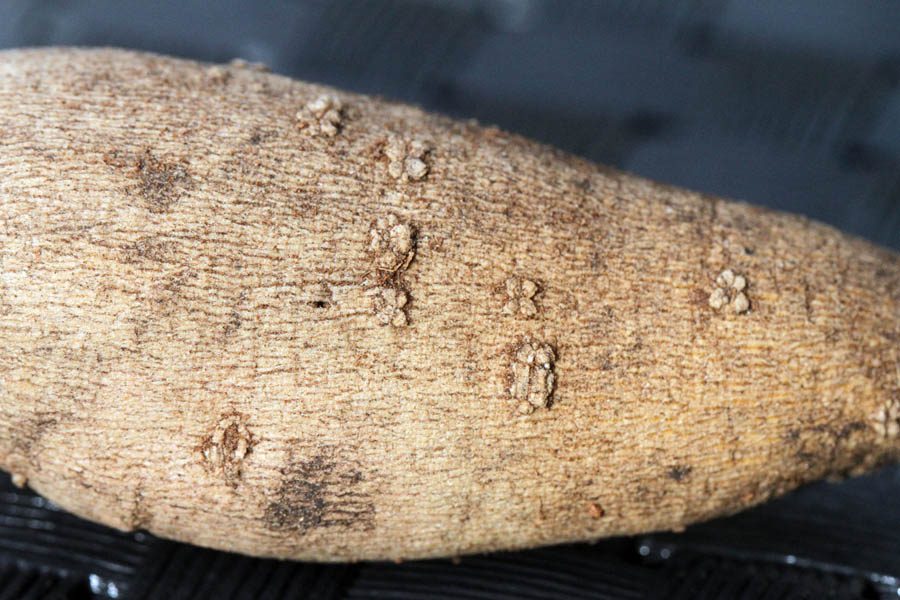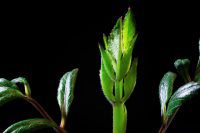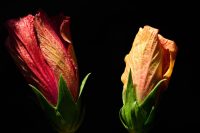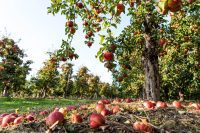What are lenticels? Ι How is gas exchanged via the lenticels? Ι Lenticels on dahlia tubers Ι What is the difference between lenticels and gall?
Lenticels are raised breathing pores or protrusions located in the periderm (the thickened protective outer layer) and skin of certain plants and fruit. Their function is to allow the exchange of oxygen and carbon dioxide to and from the internal tissues.
The protective layer of the dahlia tuber, similar to the periderm in woody plants, is made of compacted cells that are largely impermeable to gases. Lenticels interrupt this layer, allowing for necessary gas exchange. This exchange of gases is critical for the living tissue located beneath the periderm. Cells within the lenticels contain small spaces known as ‘intercellular spaces‘, which provide a pathway for gasses to move between the internal tissues and the outside environment.
The term ‘lenticel‘ comes from the Latin word ‘lenticula,’ which means ‘small lentil’, about the raised, lens-shaped spots on the surface of a plant stem, tuber or fruit that resemble the shape of a lentil.
What’s the difference between stomata and lenticels?
While lenticels and stomata perform similar functions, they are not the same.
Stomata (singular: stoma) are tiny pores found on the surface of leaves and young green stems. These pores are surrounded by two specialised cells known as guard cells. Guard cells control the opening and closing of the stomata. The primary function of stomata is to regulate the exchange of gases, particularly water vapour and carbon dioxide, between the plant and the environment. When stomata are open, carbon dioxide can enter the plant for use in photosynthesis, while water vapour is released into the air as a byproduct of transpiration. When stomata are closed, the plant conserves water and reduces the loss of water vapour.
| Feature | Stomata | Lenticels |
|---|---|---|
| Location | Found primarily on leaf surfaces (especially lower surfaces). Can also appear on young green stems. | Located woody stems, fruits, and other woody parts of the plant. |
| Structure | Made up of two guard cells surrounding a pore. | Spongy areas in the periderm with loosely arranged cells, lacking specialised cells like guard cells. |
| Primary Function | Facilitate uptake of CO₂ for photosynthesis and release O₂. | Facilitate gas exchange (O₂ in, CO₂ out) in woody tissues. |
| Regulation | Regulated by guard cells based on various internal and external factors. |
No active regulation; spongy tissue remains open to the atmosphere. |
| Development | Develop from specialised epidermal cells. | Result from the activity of the cork cambium and subsequent periderm development. |
| Appearance | Typically microscopic, requiring a microscope for clear observation. | Often visible to the naked eye as small, raised, rough spots or lines on woody surfaces. |
| Additional Functions | Play a significant role in transpiration (water vapour loss). | Allow underlying tissues to respire by providing O₂ and releasing CO₂, especially where other forms of gas exchange are restricted. |
How is gas exchanged via the lenticels?
The process of gas exchange occurs through diffusion, which is the movement of molecules from an area of high concentration to an area of low concentration. Oxygen and carbon dioxide molecules move from areas of high concentration outside the plant to areas of lower concentration inside the plant, or vice versa, through the pores of the lenticels.
The rate of gas exchange through lenticels depends on several factors, such as the size and number of lenticels, thickness and permeability of the epidermis, temperature and humidity of the surrounding environment, and the metabolic activity of the plant.
In addition to facilitating gas exchange, lenticels also play a role in regulating the water balance of the plant. They can become more or less permeable to gases and water depending on the environmental conditions, helping to prevent the plant from losing too much water through transpiration.
Lenticels on dahlia tubers
When dahlias are exposed to prolonged wet conditions, the tissues in the lenticels swell and become more pronounced in a condition called ‘lenticel hypertrophy‘. Air-filled spaces known as soil pores decline in waterlogged soil, which starves the roots and tubers of oxygen. When a plant experiences excess moisture, lenticels become more permeable, which allows for a greater exchange of gases and water vapour. This increased permeability can cause the lenticels to swell, becoming more prominent on the surface of the stem.
When dahlias endure extended periods of dampness, a phenomenon known as lenticel hypertrophy occurs, wherein the lenticels undergo enlargement and become more conspicuous – a condition often first noticed by gardeners during such wet spells. The presence of excess water causes a reduction in the air-filled cavities within the soil, termed soil pores, leading to an oxygen deficit for the roots and tubers. In response to the heightened moisture levels, the lenticels enhance their permeability to facilitate a more robust exchange of gases and water vapor. This adaptive response, lenticel hypertrophy, results in the noticeable swelling of these structures on the dahlia’s stem surface.
Anaerobic (which means ‘without air‘) respiration is a type of respiration that occurs when plants have limited access to oxygen. During anaerobic respiration, plants produce ethanol, which can build up to toxic levels in the plant tissues. Lenticels provide a more efficient and safer exchange of gases including oxygen which is necessary for aerobic respiration.
Injury to the stem can also cause lenticels to swell. When a plant is wounded, the cells in the surrounding tissue can release chemicals that stimulate the production of new cells and the formation of calluses. As this process occurs, the lenticels near the injured area may become swollen, as the increased activity of surrounding cells causes the pores to enlarge.
Lenticels in dahlias are cosmetic only and do not impact the health or growth of the plant.
Lenticels and dahlia storage
While lenticels serve an important function, they can impact the storage life of dahlia tubers. During storage, dahlia tubers respire, consuming oxygen and producing carbon dioxide and water vapour. If dahlia tubers are stored in an environment with high humidity, the lenticels can become more permeable, allowing for greater gas exchange and leading to increased water loss and faster deterioration of the tuber.
Additionally, the presence of lenticels can provide a site for infection by fungi or bacteria, which can further reduce the storage life of the tuber. In some cases, the lenticels may even serve as an entry point for insects or other pests, which can damage or feed on the tuber and further reduce its quality.
Dahlia tubers with fewer lenticels may be more resistant to moisture loss, and fungal and bacterial infections, leading to a longer storage life. Other factors such as temperature, humidity, and the presence of pathogens can also play a significant role in the storage life of dahlia tubers. Proper storage conditions, including cool temperatures and low humidity, will extend the storage life of dahlia tubers, regardless of the number of lenticels present.
What is the difference between lenticels and gall?
Crown gall, or gall, is a serious bacterial infection caused by the soil-borne bacterium Rhizobium radiobacter (syn. Agrobacterium tumefaciens) which occurs on woody shrubs and herbaceous plants. Affected dahlias develop distorted growths on the crown (base of the stem) of the tuber. Dahlias with crown gall should be carefully disposed of in the garbage, and not composted.
Take care when handling dahlia tubers to avoid damaging them, which provides an entry site for the R. radiobacter. Solarisation can help to reduce the number of pathogens in the soil.
Conclusion
- Lenticels are small, corky structures that facilitate gas exchange on the surface of dahlias and other woody plants.
- Normally, lenticels are difficult to see with the naked eye, however, when exposed to prolonged wet conditions, lenticels swell and become more visible.
- Regular inspection of stored dahlia tubers can help prevent the spread of disease and ensure a healthy growing season.
Julia is a writer and landscape consultant from Wollongong with a love of horticulture. She had been an avid gardener for over 30 years, collects rare variegated plants and is a home orchardist. Julia is passionate about learning and sharing her knowledge of plant propagation and plant toxicology. Whether it’s giving advice on landscape projects or sharing tips on growing, Julia enjoys helping people make their gardens flourish.




